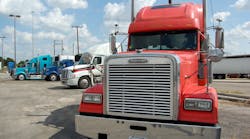Strong U.S. freight demand driven by a recent resurgence in housing and manufacturing activity may be partially offset by a lackluster forecast for overall economic growth coupled to a more dire shortage of truck drivers.
May spot market freight availability, for example, increased 40% versus the same month in 2013 as measured by the DAT North American Freight Index – the 11th consecutive month to post a year-over-year record increase.
On a cargo-specific basis, DAT said May spot freight demand for dry vans increased 25%, refrigerated by 18%, and flatbed by 85% to May 2013.
A rebound in manufacturing activity is helping drive overall freight demand as well, with the one indicator – the Empire Manufacturing Index (EMI) – jumping from 19.01 to 19.28 in June, the highest level in four years. According to the EMI, new orders rebounded from negative 2.77 to a positive 10.44 in May, a four-month, with shipments gaining from 3.15 to 17.44.
Lindsey Piegza, chief economist for Wall Street investment firm Sterne Agee, said in a research brief that manufacturing capacity utilization also improved more than expected according to EMI data, rising from 78.9% to 79.1% in May. On top of that, industrial production rose 0.6% in May after a 0.3% decline in April.
“Manufacturing activity appears to be improving after the worst performance in years,” Piegza said. “Going forward, however, a sustained recovery in production must be supported by larger gains in consumption and business investment. At this point, it is too early to tell if there is sustained momentum in either of these sectors with the most recent data showing a significant slowdown in early Q2 after a short-lived rebound in February and March.”
That mixed message is reflected in DAT’s numbers, too, as month-over-month spot freight volumes declined 2.1% in May compared to April, with month-over-month van freight availability dropping by 1%, while reefer freight dropped 4.8% and flatbed volume lost 1.6%.
From a broader economic perspective, recent analysis by the International Monetary Fund (IMF) concluded that while a “meaningful rebound” in U.S. economic activity is now underway, this “renewed dynamism” provides only a partial offset to the weak first quarter when the harsh winter weather conspired with other factors – including inventory drawdown, a still-struggling housing market, and slower external demand – to slow down U.S. economic momentum.
Right now, IMF is projected overall gross domestic production (GDP) growth from the U.S. of 2% for all of 2014, rising to 3% in 2015.
“Potential growth is forecast to average around 2% for the next several years,” the group said. “A combination of factors is at work in lowering longer-run growth including the effects of population aging and more modest prospects for productivity growth.”
The IMF added that U.S. job growth has been healthy but labor markets are weaker than is implied by the headline unemployment number: long-term unemployment is high, labor force participation is well below what can be explained by demographic factors, and wages are stagnant.
“With better growth prospects, the U.S. should see steady progress in job creation,” the group noted in its analysis. “However, headline unemployment is expected to decline only slowly—in part because improving prospects will draw discouraged workers back into the labor force—and long-term unemployment will take time to fall to historic levels.”
In a conference call last Friday, Wall Street investment firm Stifel Nicolaus & Co. characterized U.S. economic growth as “lackluster,” with manufacturing demand largely driven by replacement and replenishment demand rather than incremental growth.
“The lackluster U.S. economy has provided a tepid freight environment which has been characterized weak growth, at best,” the firm said. “Fleets have generally downsized to match capacity with uninspiring demand.”
Yet simultaneously finding people willing to drive trucks for a living is getting much, much harder, noted Gordon Klemp, founder and president of the National Transportation Institute (NTI), during the Stifel call – especially as the current age of the driver pool continues climbing.
“The driver force is aging rapidly [with] 56% of for-hire truckload drivers 45 or older [and] 59% of private fleet drivers are 45 or older,” Klemp explained. “Given this aging demographic, the cavalcade of driver pool shrinking and productivity sapping safety regulations coming down the federal pipeline, and drivers’ penchant to retire earlier than many due to nagging health issues, the driver shortage issue is likely to get much worse before it gets better.”
For that reason, Stifel still believes the “mother of all capacity shortages” is still on its way for the trucking industry, although the firm said it does not appear that 2014 will be the year when the shortage rears its ugly head.
“Rather, we will need to see some additional economic growth and the implementation of some additional capacity-reducing regulations,” Stifel noted in its analysis. “Our sense is that the ‘mother of all shortages’ will appear in the 2016-2018 timeframe, as by then the industry will be dealing with mandatory electronic logging devices (ELDs), speed limiters, hair follicle drug testing, sleep apnea testing, etc. and the economy will likely have expanded, albeit only modestly, by then.”



